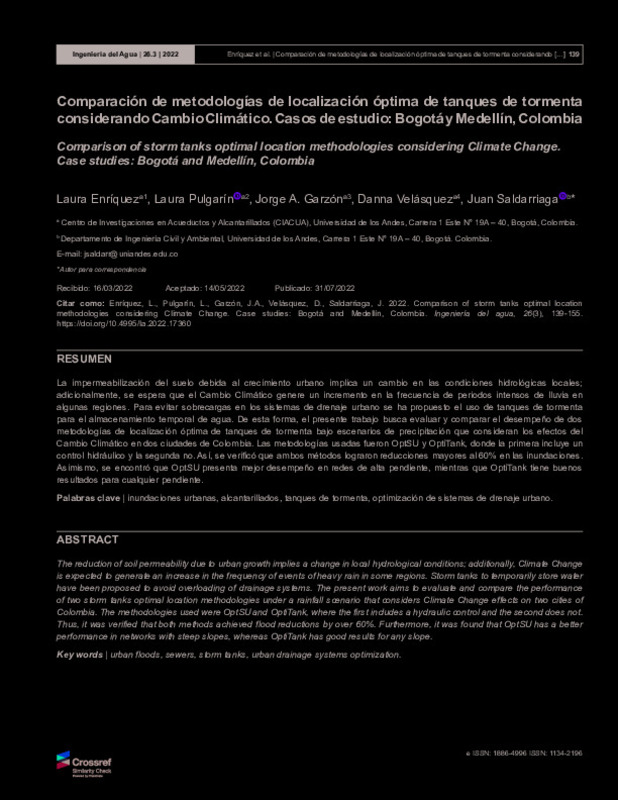Andrés-Doménech, I., Montanari, A., Marco, J.B. 2011. Efficiency of Storm Detention Tanks for Urban Drainage Systems under Climate Variability. Journal of Water Resources Planning and Management, 138(1), 36-46. https://doi.org/10.1061/(asce)wr.1943-5452.0000144
Berggren, K., Olofsson, M., Viklander, M., Svensson, G., Gustafsson, A.M. 2011. Hydraulic impacts on urban drainage systems due to changes in rainfall caused by climatic change. Journal of Hydrologic Engineering, 17(1), 92-98. https://doi.org/10.1061/(ASCE)HE.1943-5584.0000406
Camilloni, I. 2014. Reunión Aproximación Delta Change. Bogotá. (Octubre de 2014).
[+]
Andrés-Doménech, I., Montanari, A., Marco, J.B. 2011. Efficiency of Storm Detention Tanks for Urban Drainage Systems under Climate Variability. Journal of Water Resources Planning and Management, 138(1), 36-46. https://doi.org/10.1061/(asce)wr.1943-5452.0000144
Berggren, K., Olofsson, M., Viklander, M., Svensson, G., Gustafsson, A.M. 2011. Hydraulic impacts on urban drainage systems due to changes in rainfall caused by climatic change. Journal of Hydrologic Engineering, 17(1), 92-98. https://doi.org/10.1061/(ASCE)HE.1943-5584.0000406
Camilloni, I. 2014. Reunión Aproximación Delta Change. Bogotá. (Octubre de 2014).
Cimorelli, L., Morlando, F., Cozzolino, L., Covelli, C., Della Morte, R., Pianese, D. 2016. Optimal positioning and sizing of detention tanks within urban drainage networks. Journal of Irrigation and Drainage Engineering, 142(1), 04015028. https://doi.org/10.1061/(ASCE)IR.1943-4774.0000927
Cunha, M.C., Zeferino, J.A., Simões, N.E., Saldarriaga, J.G. 2016. Optimal location and sizing of storage units in a drainage system. Environmental Modelling & Software, 83, 155-166. https://doi.org/10.1016/J.ENVSOFT.2016.05.015
Du, S., Shi, P., Van Rompaey, A., Wen, J. 2015. Quantifying the impact of impervious surface location on flood peak discharge in urban areas. Natural Hazards, 76, 1457-1471. https://doi.org/10.1007/s11069-014-1463-2
Duan, H.F., Li, F., Yan, H. 2016. Multi-Objective Optimal Design of Detention Tanks in the Urban Stormwater Drainage System: LID Implementation and Analysis. Water Resources Management, 30(13), 4635-4648. https://doi.org/10.1007/s11269-016-1444-1
EPA Office of Wastewater Management. 2015. Why Control Sanitary Sewers Overflows? https://www.epa.gov/sites/production/files/2015-10/documents/sso_casestudy_control.pdf
Esri Inc. 2018. ArcGIS Desktop (10.7). Environmental Systems Research Institute Inc.
Gordon-Walker, S., Harle, T., Naismith, I. 2007. Cost-benefit of SUDS retrofit in urban areas (Science Report-SC060024). https://assets.publishing.service.gov.uk/government/uploads/system/uploads/attachment_data/file/290993/scho0408bnxz-e-e.pdf
IDEAM, PNUD, MADS, DNP, Cancillería. 2015. Escenarios de Cambio Climático para Precipitación y Temperatura para Colombia 2011-2100. Herramientas Científicas para la Toma de Decisiones-Estudio Técnico Completo: Tercera Comunicación Nacional de Cambio Climático. http://documentacion.ideam.gov.co/openbiblio/bvirtual/022963/escenarios_cambioclimaticodepartamental/Estudio_tecnico_completo.pdf
Iglesias, P., Martínez, J., Saldarriaga, J., Vallejo, D. 2014. Localización de tanques de tormenta para control de inundaciones mediante un algoritmo pseudo- genético. XIII Simpósio Iberoamericano de Redes de Agua.
Khazaei, M.R., Zahabiyoun, B., Saghafian, B. 2012. Assessment of climate change impact on floods using weather generator and continuous rainfall-runoff model. International Journal of Climatology, 32, 1997-2006. https://doi.org/10.1002/joc.2416
Li, F., Duan, H.F., Yan, H., Tao, T. 2015. Multi-Objective Optimal Design of Detention Tanks in the Urban Stormwater Drainage System: Framework Development and Case Study. Water Resources Management, 29(7), 2125-2137. https://doi.org/10.1007/s11269-015-0931-0
Llopart-Mascaró, A., Farreny, R., Gabarrell, X., Rieradevall, J., Gil, A., Martínez, M., Puertas, J., Suárez, J., Río, H. del, Paraira, M. 2015. Storm tank against combined sewer overflow: Operation strategies to minimise discharges impact to receiving waters. Urban Water Journal, 12(3), 219-228. https://doi.org/10.1080/1573062X.2013.868499
Ministerio de Vivienda Ciudad y Territorio. 2016. Reglamento Técnico del Sector de Agua Potable y Saneamiento Básico: TITULO D. Sistemas de recolección y evacuación de aguas residuales domésticas y aguas lluvias / Viceministerio de Agua y Saneamiento Básico.
Myhre, G., Alterskjær, K., Stjern, C.W., Hodnebrog, Marelle, L., Samset, B.H., Sillmann, J., Schaller, N., Fischer, E., Schulz, M., Stohl, A. 2019. Frequency of extreme precipitation increases extensively with event rareness under global warming. Scientific Reports, 9(16063). https://doi.org/10.1038/s41598-019-52277-4
Nie, L., Lindholm, O., Lindholm, G., Syversen, E. 2009. Impacts of climate change on urban drainage systems –a case study in Fredrikstad, Norway. Urban Water Journal, 6(4), 323-332. https://doi.org/10.1080/15730620802600924
Oxley, R.L., Mays, L.W. 2014. Optimization - Simulation Model for Detention Basin System Design. Water Resources Management, 28, 1157-1171. https://doi.org/10.1007/s11269-014-0552-z
Prudhomme, C., Reynard, N., Crooks, S. 2002. Downscaling of global climate models for flood frequency analysis: Where are we now? Hydrological processes, 16, 1137-1150. https://doi.org/10.1002/hyp.1054
Pulgarín Dávila, E.G. 2009. Fórmulas regionales para la estimación de curvas intensidad - frecuencia - duración basadas en las propiedades de escala de la lluvia (región andina colombiana). http://bdigital.unal.edu.co/2467/
Rossman, L. 2015. Storm Water Management Model User’s Manual Version 5.1 - manual.
Ruiter, A. 2012. Delta-change approach for CMIP5 GMCs. De Bilt: Royal Netherlands Meteorological Institute.
Saldarriaga, J., Salcedo, C., Solarte, L., Pulgarín, L., Rivera, M.L., Camacho, M., Iglesias-Rey, P.L., Martínez-Solano, F.J., Cunha, M. 2020. Reducing Flood Risk in Changing Environments: Optimal Location and Sizing of Stormwater Tanks Considering Climate Change. Water, 12(9), 2491. https://doi.org/https://doi.org/10.3390/w12092491
Solman, S., Nuñez, M. 1999. Local estimates of global climate change: A statistical downscaling approach. International Journal of Climatology, 19, 835-861. https://doi.org/10.1002/(SICI)1097-0088(19990630)19:8%3C835::AID-JOC401%3E3.0.CO;2-E
United States Department of Agriculture (USDA). 1986. Urban Hydrologyfor Small Watersheds. https://www.nrcs.usda.gov/Internet/FSE_DOCUMENTS/stelprdb1044171.pdf
Universidad de los Andes PAVCO. 2014. Drenaje Urbano y Cambio Climático FASE I-II: Hacia los sistemas de alcantarillado del futuro. Bogotá. Informe final no publicado.
US Environmental Protection Agency (EPA). 2011. Storm Water Management Model (SWMM) (5.0.022). Environmental Protection Agency (EPA).
Willems, P., Arnbjerg-Nielsen, K., Olsson, J., Nguyen, V. 2012. Climate change impact assessment on urban rainfall extremes and urban drainage: Methods and shortcomings. Atmospheric research, 103, 106-118. https://doi.org/10.1016/j.atmosres.2011.04.003
Willems, P., Olsson, J., Arnbjerg-Nielsen, K., Beecham, S., Pathirana, A., Bulow Gregersen, I., et al. 2012. Impacts of Climate Change on Rainfall Extremes and Urban Drainage Systems. IWA Publishing. https://doi.org/10.2166/9781780401263
Zeferino, J.A., Antunes, A.P., Cunha, M.C. 2009. An efficient simulated annealing algorithm for regional wastewater system planning. Computer-Aided Civil and Infrastructure Engineering. https://doi.org/10.1111/j.1467-8667.2009.00594.x
[-]









